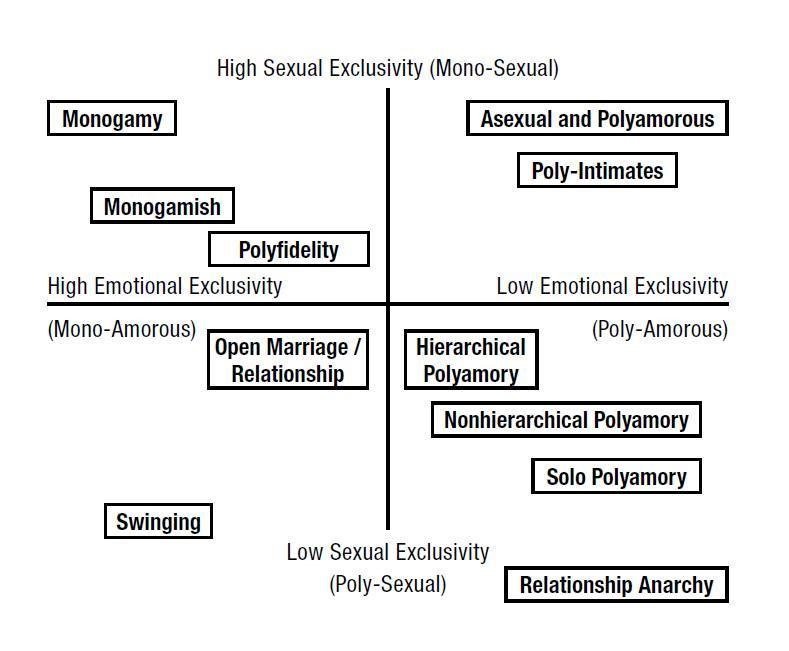Forms of Non-Monogamy
from Fern, Jessica. Polysecure: Attachment, Trauma and Consensual Nonmonogamy Thornapple Press, 2020.
This chart is from Jessica Fern’s wonderful 2020 book Polysecure: Attachment, Trauma and Consensual Nonmonogamy.
The chart maps out the most common forms of non-monogamy along two axes; Emotional Exclusivity along the horizontal axis, and Sexual Exclusivity along the vertical axis.
I find that these two axes are the most realistic way that people who are actually practicing non-monogamy use to sort out their style of non-monogamy based on their wants and needs and communicating those with their partners.
Definitions:
Monogamy: A form of relationship where a person has only one partner either for their lifetime or at a time (serial monogamy).
Monogamish: Coined by Dan Savage in 2011, this refers to a monogamous relationship that is not 100% monogamous but is not open either.
Polyfidelity: Often called Closed Polyamory, this is where the form of the relationships is polyamorous but all involved have decided to date each other exclusively.
Open Marriage:
Swinging: An arrangement where individuals in otherwise committed relationships engage in consensual sexual activities for recreational purposes. Colloquially referred to as Parts Not Hearts.
Hierarchical Polyamory: A form of polyamory where the expectation is that some relationships at time may be prioritized over others or have more influence in shaping rules or parameters of dynamics.
Parallel Polyamory: A form of polyamory where each relationship is treated as distinct entities with little to no intentional entanglement between relationships. Can be seen as the opposit of Kitchen Table Polyamory.
Kitchen Table Polyamory: A form of polyamory where the harmony or cooperation of the entire network of individuals is a priority and close relationships between metamours and telemours is encouraged and sometimes required.
Nonhierarchical Polyamory: The opposite of Hierarchical Polyamory, Nonhierarchical polyamory does not set an expectation that any specific relationship will necessarily be prioritized over others in a given situation. This does not preclude the necessary hierarchies of daily life (e.g. cohabitation, child rearing, etc.) but the goal is to limit hierarchy and to include everyone who might be impacted by a decision in the decision-making process when possible.
Solo Polyamory: The concept that one practices polyamory as ones own primary partner and operates with an elevated amount of autonomy and direction.
Relationship Anarchy (RA): RA means lots of different things to different practitioners but the essence of it is the rejection of labels or a priori expectations on any relationship. They tend to reject the idea that any intimate relationship is more important than any other. In this framework, intimate friendships could have equal import to intimate sexual partners or intimate romantic partners. RA transcends relationship style is much of a philosophy of life.
